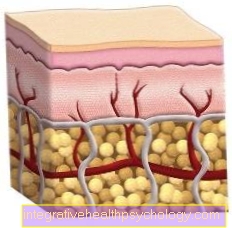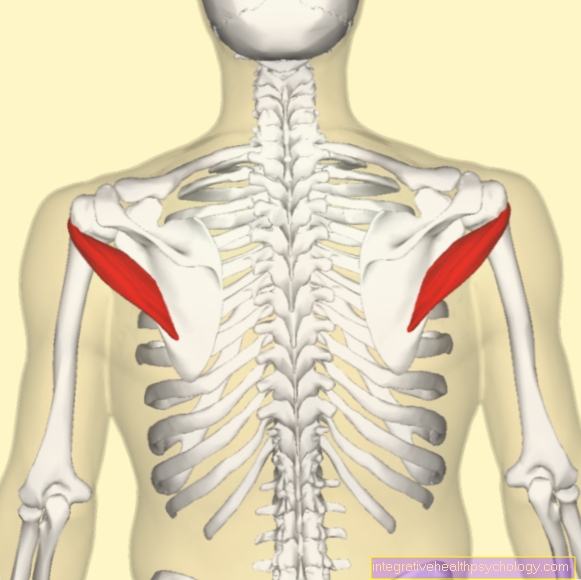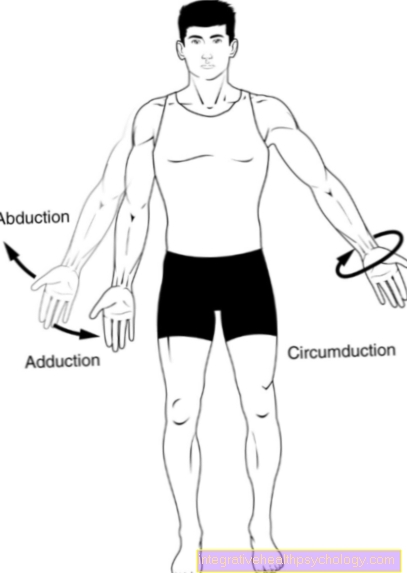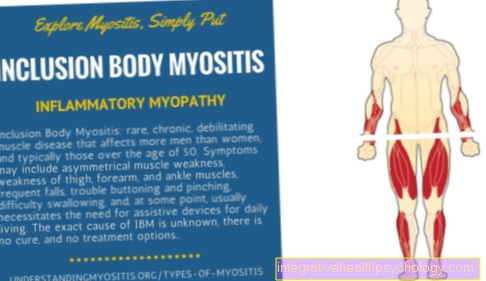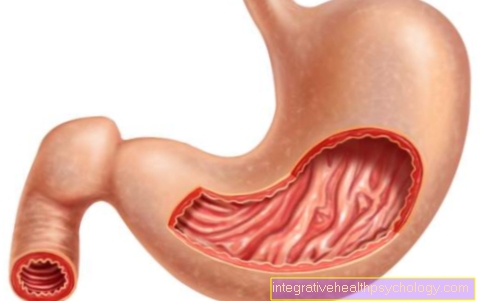Ambroxol
Synonyms in the broader sense
Mucosan®, Mucoangin®, Mucosolvan®, Lindoxyl®, mucolytic, secretolytic, ambroxol hydrochloride, expectorant, local anesthetic
Introduction / definition
Ambroxol is an active ingredient that is mainly used as a cough remover in medication. It has an expectorant effect on the lungs and bronchi and has a slightly numbing effect on the throat.
Ambroxol is therefore often used for colds with particularly stubborn mucus and for acute or chronic respiratory diseases.

Mode of action
Primarily can two important effects of the drug: the expectorant and the analgesic effect.
First of all, the first effect: with every breath you take in oxygen with the air and release carbon dioxide, thereby keeping the body's oxygen supply constant. Breathing air reaches the alveolar system of the lungs via the upper and lower airways, where the actual oxygen exchange takes place.
One of the upper respiratory tract is one Nasal cavity and the Sinuses, the Oral cavity and the throat.
You are with one mucous membrane rich in glands and vessels lined that with respiratory epithelium (Ciliated epithelium), which extends into the bronchi. The glands form one Mucus layerthat covers the epithelium like a sticky film. This layer is used to humidify the inflowing air and inhaled dirt and dust particles as well as pathogens stick to it. So-called cilia on the epithelium transport the mucus together with the particles to the throat, where they are swallowed and thus eliminated.
Colds disrupt this cleaning mechanism of the body. The The mucous membranes swell and it forms very tough mucus that sticks the cilia and that kind of thing Prevents pollutants from being transported towards the throat. By the irritation of the respiratory tract, the mucous membrane becomes one via sensory cells Cough reflex triggered and the thick mucus is coughed up painfully.
Ambroxol works by taking it makes tough mucus more fluid again and thus prevents the cilia from sticking together. It also mobilizes the hairs in addition to accelerated removal of the mucus towards the throat and stimulates the formation of surfactant, a surface-active substance that lowers the surface tension of the sticky mucus and thus enables easier expectoration.
The second pain relieving effectst will especially with severe sore throat exploited. Ambroxol inhibits the development and transmission of excitation of pain fibers that are localized in the cells of the mucous membrane.
Application of Ambroxol
Ambroxol is pharmacy only and in many different dosage forms to get.
The active ingredient is often used in Cough Syrup or in drop form in dosages 3; 6; 7.5 and 15 mg per ml. Ambroxol is also available as Film or effervescent tablet (30 or 60 mg), as Lozenge (15 or 20 mg), as Retard preparation in the dose of 75 mg, as well as in Suppository shape (15 mg) and as Inhalation solution (7.5 mg / ml).
In addition to these monopreparations, Ambroxol is also available as Combination preparation available. Clenbuterol, theophylline or Doxycycline used.
application
Of the attending physician decides depending on the patient’s disease progression via the appropriate application and dosage of the drug.
Ambroxol is as a cough syrup (15 mg / 5 ml solution) no longer than 4-5 days to take.
The dose varies for children and adults and is to be measured with an enclosed measuring cup:
- Children under 2 years receive ½ measuring cup with 2.5 oral solution twice a day;
- Children aged 2-5 years receive ½ measuring cup with 2.5 ml oral solution three times a day.
- In children aged 6-12 the dose increases to 1 measuring cup with 5 ml of oral solution 2-3 times a day.
- Adults and children from 12 years usually receive 2 measuring cups with 5 ml of solution 3 times a day for the first few days, then the amount is reduced to 2 measuring cups with 5 ml of solution twice a day.
Ambroxol in teardrop shape (7.5 mg / ml):
- should Children under 2 years can only be administered under medical supervision.
- At Children from 2-5 years A dose of 20 drops 3 times a day (corresponds to 1 ml of solution 3 times) is recommended.
- Children from 6-12 years receive 40 drops 2-3 times a day (corresponds to 2ml solution 2-3 times) and
- Adults or children from 12 years get 80 drops 3 times a day for the first few days (corresponds to 3 times 4ml solution), after that the amount is reduced to 2 times 80 drops a day.
In Tablet form (30 mg) is Ambroxol because of its high active ingredient content
- not for children under 6 years suitable.
- Children from 6 to 12 years receive half a tablet 2-3 times a day.
- Adults and children from 12 years receive 1 tablet 3 times a day for the first few days, then the amount is reduced to one tablet twice a day. The tablet should always be swallowed whole with a sufficient amount of liquid.
Effervescent tablets (60 mg):
- are suitable not for children under 12 years;
- Adults and children from 12 years receive ½ effervescent tablet 3 times a day for the first few days, later a reduction to ½ effervescent tablet twice a day takes place. This should be dissolved in a glass of water after meals.
Lozenges (20 mg) is available for children from 12 years of age and adults, up to 6 tablets can be taken throughout the day as required, the individual dose should not exceed one lozenge. The duration of treatment should not exceed 3 days.
Sustained release preparations (75 mg) only to children from 12 years and adultse issued, only one capsule per day is swallowed whole with plenty of fluid.
Ambroxol suppositories (15 mg) are suitable for children;
- Children under 2 years but should only be treated under medical supervision.
- At Children from 2-5 years the daily dose is 2 times 1 suppository,
- Children from 6-12 years receive 1 suppository 2-3 times a day. If possible, this should be inserted deep anal after a bowel movement.
The Inhalation solution (15 mg / 2 ml) is suitable for children under 6 years limited, here should be resorted to juice and drops. Children from 6 years and adults receive 2-3 ml for inhalation 1-2 times a day. All common inhalers that do not use the steam boiler principle are suitable for this. The solution should initially be warmed to body temperature. It can be mixed 1: 1 with physiological saline solution for the best possible moistening. Care should be taken to breathe normally when inhaling.
Dosage forms
Ambroxol as a cough syrup
A frequently used form of Ambroxol is the cough syrup. The active ingredient can work in the throat area immediately after ingestion, loosening the mucus and relieving pain. The expectorant effect can be improved by a simultaneous supply of fluids. Compared to tablets, the onset of action is faster when using the cough syrup.
Ambroxol cough syrup is available in different dosages (between 3 and 15 mg of active ingredient per ml of solution). The dosage most frequently used in the cough syrup is 15 mg per 5 ml of solution. In this dosage, intake without medical advice is not recommended for longer than 4 to 5 days. If the symptoms fail to improve, a doctor should then be consulted and further action should be discussed.
The exact daily dosage and frequency of use depends on the age of the patient. It can also be taken by children under 2 years of age. Adults and children aged 12 and over are usually given 2 measuring cups with 5 ml of solution three times a day.
Ambroxol as tablets
Another frequently used form of administration of Ambroxol is tablets. However, the effect is delayed because the active ingredient is first absorbed in the intestine and via the bloodstream to the sore throat, where it causes a mucus solution and pain relief.
Ambroxol tablets usually contain 30 milligrams of the active ingredient. Compared to the other dosage forms, this is a relatively high dosage of Ambroxol. For this reason, taking Ambroxol tablets is not suitable for children under 6 years of age. For children between 6 and 12 years of age, half a tablet should be taken two to three times a day. Children aged 12 and over and adults usually receive one tablet of Ambroxol three times a day. Ingestion with a sufficient amount of fluid is recommended.
Ambroxol tablets should not be taken for more than 4 to 5 days without medical advice. If the symptoms fail to improve, a doctor should then be consulted and further action should be discussed.
Ambroxol drops
Another form of administration of Ambroxol is the form of drops. This also has an expectorant and pain-relieving effect in the area of the throat.
Ambroxol drops contain approximately 7.5 milligrams per milliliter of the solution. The exact dosage also depends on the age of the patient. Use in children under 2 years of age is only recommended under medical supervision. Children between 2 and 6 years of age should take 20 drops three times a day, children between 6 and 12 years of age receive 40 drops three times a day, and children aged 12 and over and adults receive 80 drops three times a day.
Ambroxol drops should not be taken for more than 4 to 5 days without medical advice. If the symptoms fail to improve, a doctor should then be consulted and further action should be discussed.
Ambroxol lozenges
Another form of administration of Ambroxol are lozenges. By dissolving in the area of the oral cavity and the throat, a quick onset of action is possible. One lozenge contains around 20 milligrams of the active ingredient. Since it is a high dosage compared to the cough syrup and drops of Ambroxol, it is not allowed to be taken in children under 12 years of age. Children aged 12 and over and adults can take up to 6 lozenges throughout the day. Ambroxol lozenges should not be taken for more than 3 days. If the symptoms fail to improve, a doctor should then be consulted and further action should be discussed.
Ambroxol ointment
The active ingredient Ambroxol is also offered in the form of an ointment. However, this is usually a combination preparation with dimethyl sulfoxide, which also has analgesic and anti-inflammatory properties.
Compared to the other dosage forms of Ambroxol, the ointment is not used to dissolve mucus in respiratory diseases. Instead, the Ambroxol ointment is used to treat neuropathic pain caused by local damage to nerve fibers. The local anesthetic effect of the ointment can reduce pain in the affected skin area after just 5 to 30 minutes.
Ambroxol use during pregnancy and breastfeeding - is that possible?
Ambroxol cannot be used during pregnancy or breastfeeding. Ambroxol must be avoided in any case, especially during the first trimester of pregnancy.
The active ingredient can cross the placenta and enter the baby's bloodstream. There are insufficient study results on the exact effects of ambroxol in the baby's body.
It makes sense to switch to other expectorant (sometimes also herbal) products during pregnancy and breastfeeding.
Ambroxol and alcohol - are they compatible?
Alcohol should be avoided while taking Ambroxol. Ambroxol is metabolized and broken down in the liver after it is absorbed in the intestine.
If the liver is stressed by the regular consumption of alcohol, damage to the liver tissue can occur. Conversely, the metabolism and breakdown of ambroxol can be restricted if the liver is already damaged.
An adjustment of the dosage of Ambroxol is required in this case.
Ambroxol and the pill are compatible?
There is no known interaction between Ambroxol and the pill. Studies and test results could not show any influence of Ambroxol on the effectiveness of the pill.
Some studies reported only a minor effect on the consistency of the uterine lining (increased permeability for sperm), but this has no relevant effect on the effectiveness of the pill.
Does Ambroxol require a prescription?
Ambroxol is available without a prescription in pharmacies. However, due to a wide range of side effects, advice from the treating doctor or a pharmacist is recommended. In addition, due to the metabolism of the preparation in the liver, there is a risk of interaction with other drugs.
Adjustment of the dosage in case of kidney or liver dysfunction is also necessary.
If there is no improvement in the symptoms of a respiratory disease during therapy with Ambroxol, a doctor should be consulted within a few days and the further course of action discussed.
Alternatives to Ambroxol
There are numerous alternatives to ambroxol for loosening mucus and relieving pain in acute and chronic respiratory diseases.
A commonly used preparation is acetylcysteine (ACC). It is an expectorant drug that is often prescribed as part of the treatment of a chronic cough. Acetylcysteine has a different mechanism of action from ambroxol.
A combination of acetylcysteine with ambroxol is not recommended, as many and sometimes serious side effects can occur.
Side effects
Frequently after taking Ambroxol Diarrhea observed.
Occasionally it happens to nausea and Vomit, accompanied by stomach pain. Also can fever and Hypersensitivity reactions occur (swelling, itchingDifficulty breathing and rash).
In rare cases it can too heartburn come.
Very rarely there can be an oversensitivity in one anaphylactic shock pass over. A constipation, a increased salivation, one Dehydration of the airways or heavy nasal discharge such as disturbed urination can also occur as a very rare side effect.
Contraindications
Ambroxol should not be used if one known allergy to ambroxol hydrochloride or any of the other ingredients of the drug are known.
Lozenges should not with fructose intolerance be taken, as sorbitol is used as an additive. Caution should also be exercised Galactose intolerance, Glucose-galactose intolerance and Lapp lactase deficiency.
Mucosal ulcers should not be treated with Ambroxol lozenges.
At known tendency to allergies or one sensitive bronchial system should the Avoid inhalation of Ambroxol as the muscles in the airways could cramp. If changes in the skin or mucous membranes are found, a doctor should be consulted immediately as the rare forms of Lyell or Stevens-Johnson syndrome could be present.
Patient with severe kidney and liver problems should be Ambroxol only with great caution use.
Those with kidney failure could accumulate the breakdown products of the drug in the liver.
Some rare bronchial diseases like the malignant cilia syndrome should not be treated with ambroxol, here there is a risk of secretion congestion.
The use of prolonged-release preparations should be used in Histamine intolerance not take place in the long term.
Pregnant women and Breastfeeding should refrain from treatment if possible, as Ambroxol can cross the placental barrier and also pass into breast milk. There are no adequate study results with regard to the treatment and possible side effects.
Interactions
If Ambroxol is taken with a cough suppressant (antitussive), it can be caused by a decreased cough reflex to a Collection of secretions come that cannot be coughed up.
The use of both drugs should always be accompanied by a doctor.





